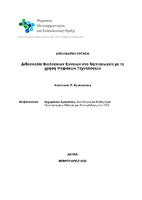| dc.contributor.advisor | Smyrnaiou, Zacharoula | |
| dc.contributor.author | Κουλουκάκη, Αναστασία | |
| dc.date.accessioned | 2022-03-21T10:29:20Z | |
| dc.date.available | 2022-03-21T10:29:20Z | |
| dc.date.issued | 2022-02-24 | |
| dc.identifier.uri | https://polynoe.lib.uniwa.gr/xmlui/handle/11400/1935 | |
| dc.identifier.uri | http://dx.doi.org/10.26265/polynoe-1786 | |
| dc.description.abstract | Η έρευνα έχει ως αντικείμενο την διάκριση έμβιων όντων, δηλαδή των όντων που έχουν ζωή (ζωντανών οργανισμών) και των άβιων όντων, δηλαδή των αντικειμένων που δεν έχουν ζωή και σε αυτή συμμετείχαν δέκα μαθητές δημόσιου νηπιαγωγείου της Αθήνας. Η σημασία του αντικειμένου αναδεικνύεται από πολλές έρευνες στην σύγχρονη εποχή, καθώς η διάκριση έμβιων – άβιων όντων είναι θεμελιώδης και λειτουργική και σε αντίθεση με άλλες κατηγοριοποιήσεις (χρώμα, σχήμα, μέγεθος) είναι κοινή για κάθε γλώσσα, πολιτισμό και αναπτύσσεται νωρίς στην παιδική ηλικία. Στόχος της έρευνας είναι οι μαθητές να διακρίνουν τα έμβια από τα άβια όντα επιχειρηματολογώντας με τη χρήση βιολογικών κριτηρίων. Για το σκοπό αυτό, σχεδιάστηκαν δραστηριότητες όπου με τη χρήση κατάλληλων ψηφιακών εργαλείων και παιδαγωγικών μεθόδων θα συμβάλουν στο να αποκτήσουν οι μαθητές νηπιαγωγείου ένα σύστημα διάκρισης έμβιων-άβιων όντων χρησιμοποιώντας καθορισμένα βιολογικά κριτήρια (ανάπτυξη και διατροφή).
Μεθοδολογικά, ως καταλληλότερη επιλέχθηκε η ποιοτική έρευνα, καθώς στόχος ήταν η βαθύτερη κατανόηση των αντιλήψεων και των επιχειρημάτων των μαθητών. Η έρευνα αποτελείται από πέντε φάσεις την αρχική συνέντευξη (pre-test) τις φάσεις της διερεύνησης για τα κριτήρια της ανάπτυξης και της διατροφής, την δημιουργία ζωντανού οργανισμού επιλογής των μαθητών και την τελική συνέντευξη (post-test). Τα εργαλεία που χρησιμοποιήθηκαν για την συλλογή των δεδομένων ήταν οι συνεντεύξεις, η παρατήρηση και τα παραγόμενα των μαθητών. Η έρευνα είχε ως στόχο να απαντήσει στα εξής ερευνητικά ερωτήματα: α) Ποια κριτήρια χρησιμοποίησαν οι μαθητές για να κατατάξουν ένα ον στα έμβια ή στα άβια όντα πριν την διδακτική παρέμβαση; β)Ποια κριτήρια χρησιμοποίησαν οι μαθητές μετά την διδακτική παρέμβαση; Τα κριτήρια αυτά τροποποιήθηκαν σε σχέση με τα αρχικά; γ) Σε τι βαθμό επιχειρηματολόγησαν οι μαθητές για την επιλογή τους να κατατάξουν ένα ον στα έμβια ή στα άβια όντα μετά την διδακτική παρέμβαση;
Από την ανάλυση των αποτελεσμάτων προέκυψαν πλήθος κριτηρίων, βιολογικών και μη, που αξιοποίησαν οι μαθητές για το διαχωρισμό έμβιων – άβιων πριν την διδακτική παρέμβαση. Τα κριτήρια αυτά, μετά την διδακτική παρέμβαση διαφοροποιήθηκαν και η επιχειρηματολογία των μαθητών για τον άνθρωπο και τα ζώα ήταν ιδιαίτερα ισχυρή, με τη χρήση δύο βιολογικών κριτηρίων, ενώ πιο αδύναμη ήταν για τα φυτά και τα άβια όντα. | el |
| dc.format.extent | 75 | el |
| dc.language.iso | el | el |
| dc.publisher | Πανεπιστήμιο Δυτικής Αττικής | el |
| dc.publisher | Εθνικό και Καποδιστριακό Πανεπιστήμιο Αθηνών | el |
| dc.publisher | Ανώτατη Σχολή Παιδαγωγικής και Τεχνολογικής Εκπαίδευσης (Α.Σ.ΠΑΙ.Τ.Ε.) | el |
| dc.rights | Αναφορά Δημιουργού - Μη Εμπορική Χρήση - Παρόμοια Διανομή 4.0 Διεθνές | * |
| dc.rights | Attribution-NonCommercial-NoDerivatives 4.0 Διεθνές | * |
| dc.rights.uri | http://creativecommons.org/licenses/by-nc-nd/4.0/ | * |
| dc.subject | Ζωντανοί οργανισμοί | el |
| dc.subject | Άβια όντα | el |
| dc.subject | Μάθηση που βασίζεται σε ψηφιακά παιχνίδια | el |
| dc.subject | Διερευνητική μάθηση | el |
| dc.subject | Επιχειρηματολογία | el |
| dc.title | Διδασκαλία βιολογικών εννοιών στο νηπιαγωγείο με τη χρήση ψηφιακών τεχνολογιών | el |
| dc.title.alternative | Teaching biological concepts in early childhood using digital technologies | el |
| dc.type | Μεταπτυχιακή διπλωματική εργασία | el |
| dc.contributor.committee | Μπούμπουκα, Μαρία | |
| dc.contributor.committee | Latsi, Maria | |
| dc.contributor.faculty | Σχολή Μηχανικών | el |
| dc.contributor.department | Τμήμα Μηχανικών Πληροφορικής και Υπολογιστών | el |
| dc.contributor.master | Ψηφιακός Μετασχηματισμός και Εκπαιδευτική Πράξη | el |
| dc.description.abstracttranslated | The aim of the thesis is to distinguish living things, i.e living organisms and non-living things, i.e. objects that have no life in which ten students of a public kindergarten in Athens participated. The importance of the subject is highlighted by many researches in modern times, as the distinction between living and non-living things is fundamental, foundational and in compered to other categorizations (color, shape, size), this subject is common to any language, culture and develops early in childhood. The objective of the research is for students to distinguish living from non-living things supporting their argument by the use of biological criteria. For this purpose, activities have been designed where by using appropriate digital tools and pedagogical methods, they will contribute to the acquisition of kindergarten students with a system for distinction between living from non-living things using defined biological criteria (development and nutrition). Methodologically, qualitative research was chosen as the most appropriate, because the aim was to deepen our understanding of students' perceptions and arguments. The research consists of five phases, the initial interview (pre-test), the phases of inquiry-based learning for the development and nutrition criteria, the creation of a living organism chosen by the students and the final interview (post-test). The tools used to collect the data were interviews, observations and student creations. The research aimed to answer the following research questions: a) What criteria did students use to classify a being as living or non living before the didactic intervention? b) What criteria did the students use after the didactic intervention? Have these criteria been amended in relation to the original criteria? c) To what extent do students argue in favor of their choice to classify something as living or non-living after the didactic intervention? Analyzing the results revealed a series of criteria, both biological and non-biological, that students used for the separation of living non-living things before the didactic intervention. These criteria, after the didactic intervention were differentiated and the students' argumentation for humans and animals was particularly strong, using two biological criteria, while for plants and non-living things it was weaker. | el |


